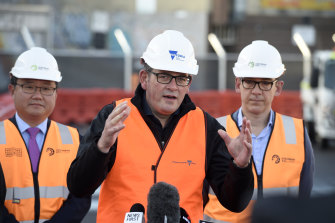For the past four years, Mark Wild has had responsibility for finally delivering a rail line that was first drawn on a map of London in 1840 and eventually took more than 20 years and the equivalent of $33 billion to build.
So it is not surprising when Wild urges people to take a long-term view about the potential benefits of the Suburban Rail Loop, a mammoth, orbital rail project currently being assessed by Infrastructure Australia expected to eventually cost up to $100 billion.
Premier Daniel Andrews argues the case for the Suburban Rail Loop.Credit:AAP
Wild agrees the pandemic has temporarily disrupted the economic model of mass transit projects traditionally justified by turnstile calculus of reduced journey times and creation of new trips.
He also believes the coronavirus crisis has brought forward a trend towards reduced demand that was already underway, with public transport patronage falling in the last pre-pandemic year by between 3.3 per cent to 6 per cent in New York, Paris and Hong Kong. In the UK, Transport for London in 2019 recorded its lowest patronage for five years.
“If you look at London, Paris and New York, there has definitely been a shift in travel patterns that I think will probably be relatively permanent,” says the former chief executive of Crossrail and managing director of the London Underground. “There is more leisure travel a Saturdays and Sundays and Mondays and Fridays are less congested than they were.
“The pandemic has probably accelerated something that was happening anyway. If you look at London in particular, Mondays and Fridays were already in decline before the pandemic came.”
In Melbourne, medium-term passenger figures can be interpreted two ways. Data provided by Victoria’s Department of Transport show that in the 10 years between 2009-10 and 2018-19, the total number of annual passengers on metro trains, trams and buses increased from 497 million to 570 million. This represents a healthy growth of 14 per cent.
However, this growth was achieved over a decade where the population of Greater Melbourne boomed by 26 per cent. This means that, when measured on a per capita basis, fewer people were using public transport at the end of the decade than they were at the start, before the pandemic hit.
Since Melbourne was plunged into its first lockdown, patronage numbers have fallen off a cliff. In 2020-21, the number of people who boarded a metro train was less than half the pre-pandemic peak and the projected figures for 2021-22, which are still being finalised, are expected to be only marginally better.
The most recent monthly data suggests a slow recovery rather than snap back, with patronage across all forms of public transport rising to 60 per cent of pre-COVID levels in May and 70 per cent in June. That was before governments and commuters started to get anxious about the current Omicron wave.
The unorthodox development of the Suburban Rail Loop, which was concealed from senior transport bureaucrats ahead of the last state election, delayed scrutiny of the project. The Victorian Opposition has promised to audit the business case for the project if it is elected in November. The Rail Futures Institute, an independent transport think tank, last week called for the project to be shelved in favour of a new rail line linking the western suburbs to central Melbourne.
Wild says London’s Crossrail – and the decision to abandon a proposed, second stage of the project – provides important lessons for post-pandemic infrastructure planning in Australia. As he points out, if a pandemic had hit London at the start of the century, the east-west Elizabeth Line might never have been built, much to the city’s detriment.
“The key to cement the Suburban Rail Loop is to have continuity,” he says. “In the UK we have made a mess of it. We should have gone onto Crossrail 2, but we have had to put that in the icebox.
“The Suburban Rail Loop is a case study of a modular railway. You could produce a factory and keep it going. The mistake would be to do a little bit, leave it for a couple of years and come back.”
Wild says the case for the Suburban Rail Loop should extend beyond direct economic benefits to the reductions in emissions that will flow from having more people ditch their cars for trains which, according to the business case, will be powered entirely by renewable energy. KPMG modelling estimates that the Cheltenham to Airport stage of the project will take 600,000 cars off Melbourne’s roads.
Wild says that London and the UK have tended to follow a boom-bust pattern of major infrastructure investment. He contrasts this with Australia where, according to figures provided by Infrastructure Partnerships Australia, there are transport project pipelines wroth $166 billion in Victoria and $123.7 billion in NSW.
“I think Suburban Rail Loop makes sense. It is something which, in 50 years time, people will think that is really smart what they did.
“As long as you are building smart stuff which is coherent, with a pipeline, in a modular way with no regrets, I think you should just get on and build it.”
The Morning Edition newsletter is our guide to the day’s most important and interesting stories, analysis and insights. Sign up here.
Most Viewed in National
From our partners
Source: Read Full Article
